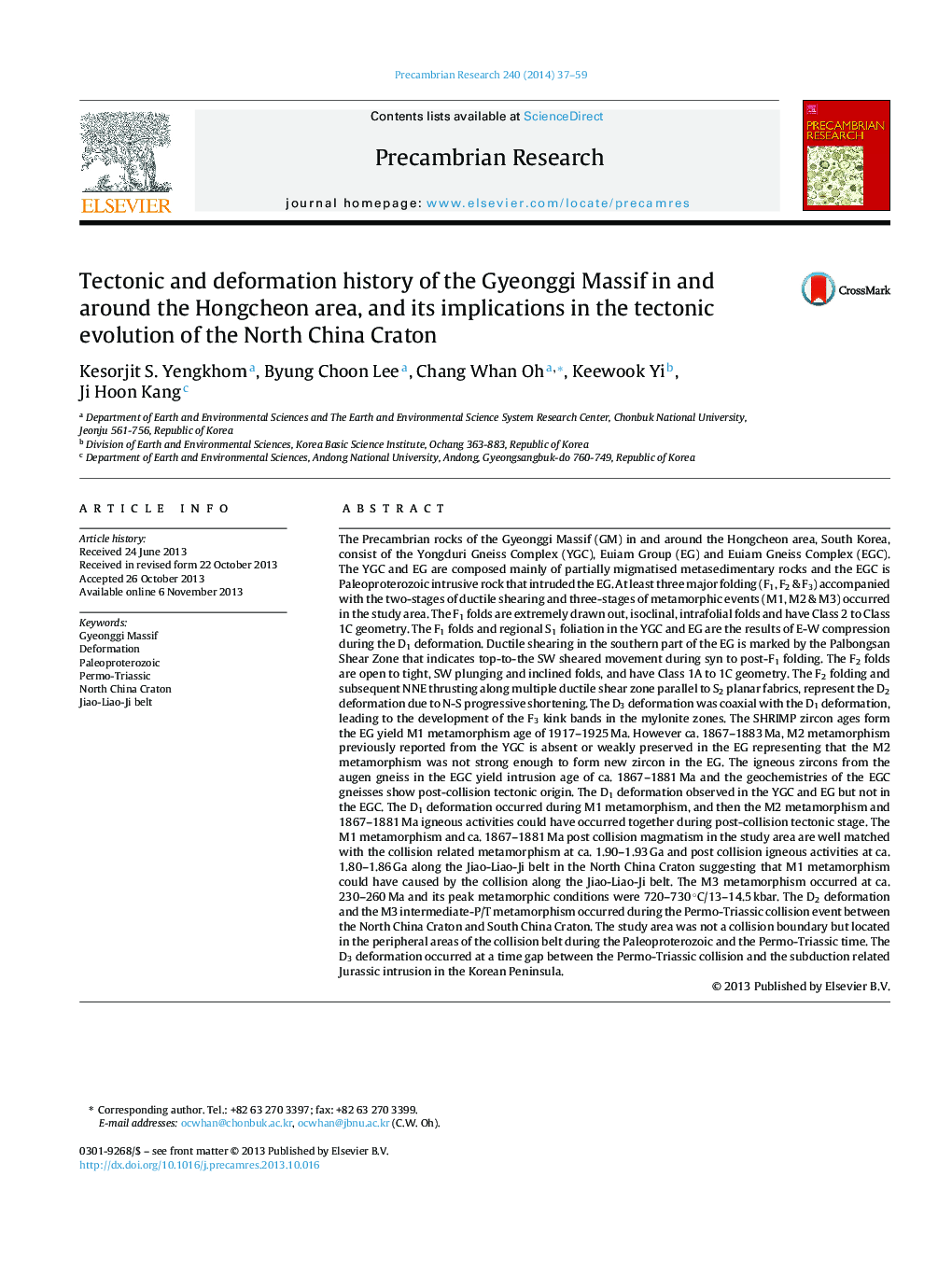| کد مقاله | کد نشریه | سال انتشار | مقاله انگلیسی | نسخه تمام متن |
|---|---|---|---|---|
| 4723026 | 1639634 | 2014 | 23 صفحه PDF | دانلود رایگان |

• D1 deformation in northern Gyeonggi Massif during collision along Jiao-Liao-Ji belt.
• The emplacement of post-collision granitoid at ca. 1867–1881 Ma.
• D2 deformation during Permo-Triassic collision between North and South China blocks.
• Intermediate-P/T metamorphism during Permo-Triassic collision.
The Precambrian rocks of the Gyeonggi Massif (GM) in and around the Hongcheon area, South Korea, consist of the Yongduri Gneiss Complex (YGC), Euiam Group (EG) and Euiam Gneiss Complex (EGC). The YGC and EG are composed mainly of partially migmatised metasedimentary rocks and the EGC is Paleoproterozoic intrusive rock that intruded the EG. At least three major folding (F1, F2 & F3) accompanied with the two-stages of ductile shearing and three-stages of metamorphic events (M1, M2 & M3) occurred in the study area. The F1 folds are extremely drawn out, isoclinal, intrafolial folds and have Class 2 to Class 1C geometry. The F1 folds and regional S1 foliation in the YGC and EG are the results of E-W compression during the D1 deformation. Ductile shearing in the southern part of the EG is marked by the Palbongsan Shear Zone that indicates top-to-the SW sheared movement during syn to post-F1 folding. The F2 folds are open to tight, SW plunging and inclined folds, and have Class 1A to 1C geometry. The F2 folding and subsequent NNE thrusting along multiple ductile shear zone parallel to S2 planar fabrics, represent the D2 deformation due to N-S progressive shortening. The D3 deformation was coaxial with the D1 deformation, leading to the development of the F3 kink bands in the mylonite zones. The SHRIMP zircon ages form the EG yield M1 metamorphism age of 1917–1925 Ma. However ca. 1867–1883 Ma, M2 metamorphism previously reported from the YGC is absent or weakly preserved in the EG representing that the M2 metamorphism was not strong enough to form new zircon in the EG. The igneous zircons from the augen gneiss in the EGC yield intrusion age of ca. 1867–1881 Ma and the geochemistries of the EGC gneisses show post-collision tectonic origin. The D1 deformation observed in the YGC and EG but not in the EGC. The D1 deformation occurred during M1 metamorphism, and then the M2 metamorphism and 1867–1881 Ma igneous activities could have occurred together during post-collision tectonic stage. The M1 metamorphism and ca. 1867–1881 Ma post collision magmatism in the study area are well matched with the collision related metamorphism at ca. 1.90–1.93 Ga and post collision igneous activities at ca. 1.80–1.86 Ga along the Jiao-Liao-Ji belt in the North China Craton suggesting that M1 metamorphism could have caused by the collision along the Jiao-Liao-Ji belt. The M3 metamorphism occurred at ca. 230–260 Ma and its peak metamorphic conditions were 720–730 °C/13–14.5 kbar. The D2 deformation and the M3 intermediate-P/T metamorphism occurred during the Permo-Triassic collision event between the North China Craton and South China Craton. The study area was not a collision boundary but located in the peripheral areas of the collision belt during the Paleoproterozoic and the Permo-Triassic time. The D3 deformation occurred at a time gap between the Permo-Triassic collision and the subduction related Jurassic intrusion in the Korean Peninsula.
Journal: Precambrian Research - Volume 240, January 2014, Pages 37–59